In Windows 10, File Explorer opens to the Quick Access folder by default. Microsoft added an option in its settings which can revert File Explorer to the classic behavior and make it open the This PC folder instead. If the user wants to open a custom folder instead This PC or Quick Access, there is no such option. Here is a way to bypass this limitation.
Advertisеment
It is very simple to make File Explorer open This PC instead of Quick Access. You only need to change one option in Folder Options as described in the article: Open This PC instead of Quick Access in Windows 10 File Explorer.
To make File Explorer open a custom folder instead of This PC or Quick Access in Windows 10, you need to apply a Registry tweak, which will set Explorer to execute a special VBscript file. In that file, you can specify the desired folder, and also change it in the future to some other folder you want. Here is how it can be done.
- Open Notepad and copy-paste the following text:
WScript.CreateObject("Wscript.Shell").Run "C:\MyFolder"Replace the portion "C:\MyFolder" with the actual path to the desired folder. In my case, I use the folder c:\apps.
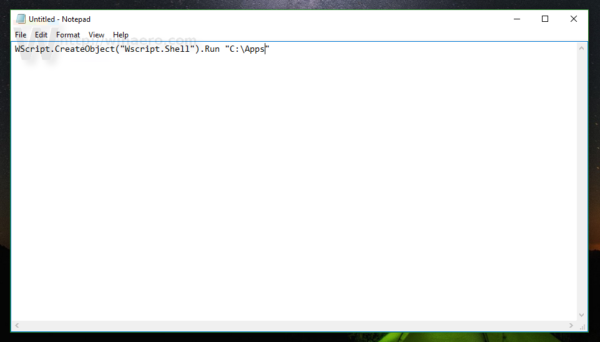
- In Notepad, save the file as launch.vbs. Save it in some per-user location where it will be safe and secure. For example, you can save it to your user profile folder. To do it, type the following (with quotes) in the Save File dialog of Notepad:
"%userprofile%\launch.vbs"
- Now, open Registry Editor.
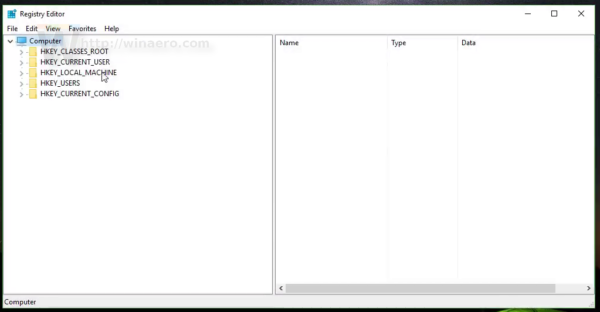 .
. - Go to the following Registry key:
HKEY_CURRENT_USER\SOFTWARE\Classes\CLSID\{52205fd8-5dfb-447d-801a-d0b52f2e83e1}\shell\opennewwindow\commandTip: See how to jump to the desired Registry key with one click.
This key does not exist by default, so you need to create it. Alternatively, you can use ready-to-use files attached below.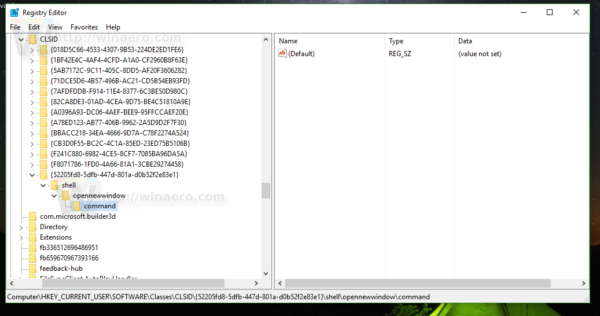
- Set the default parameter of the command subkey to the following value:
wscript.exe c:\Users\Your User Name\launch.vbs
In my case, it is
wscript.exe c:\Users\winaero\launch.vbs
- Here, create a new string value named DelegateExecute and leave its value data empty:
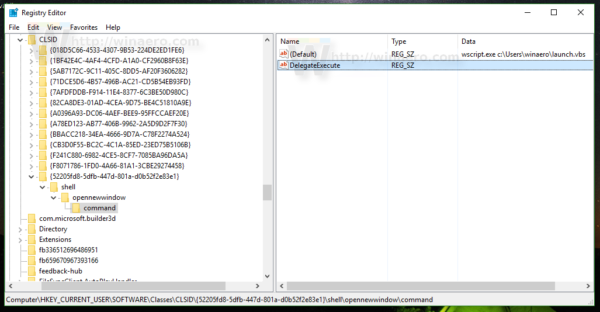
- Close Registry Editor and press Win + E to open File Explorer. It will open at C:\apps:
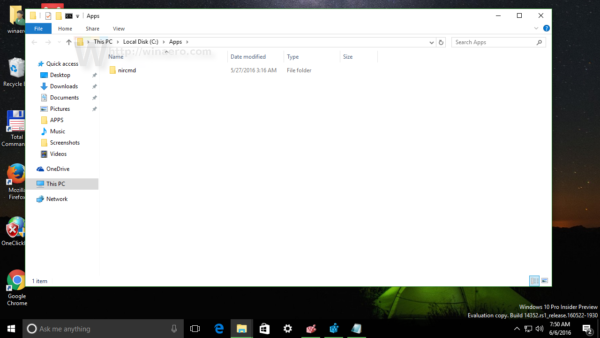
You can do the same for the File Explorer shortcut you have in the Start Menu (and pinned to the taskbar). Once you click it, the folder you specified will be opened: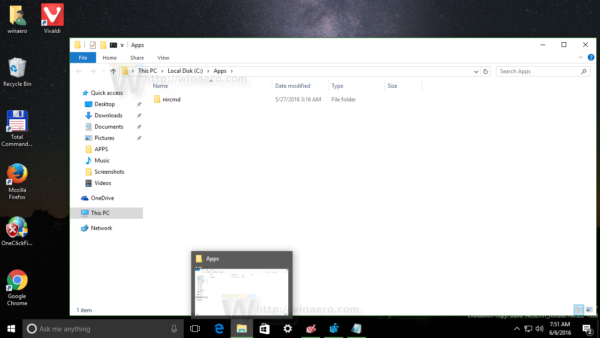
You are done. Watch the following video to see the whole tutorial in action:
To save your time, you can download these files:
Put the file launch.vbs in the folder "c:\Users\Your User Name". It is set to open the C:\ drive, but you can edit it as described above.
Then edit the file "Set custom folder for File Explorer.reg" and put your user name instead of the "your user name" portion. After that, double click this file.
To undo this change, double click the file "Restore default folders.reg".
That's it.
Do you like this trick or are you happy with the default folders of File Explorer in Windows 10? Tell us in the comments!
Support us
Winaero greatly relies on your support. You can help the site keep bringing you interesting and useful content and software by using these options:
If you like this article, please share it using the buttons below. It won't take a lot from you, but it will help us grow. Thanks for your support!
Advertisеment
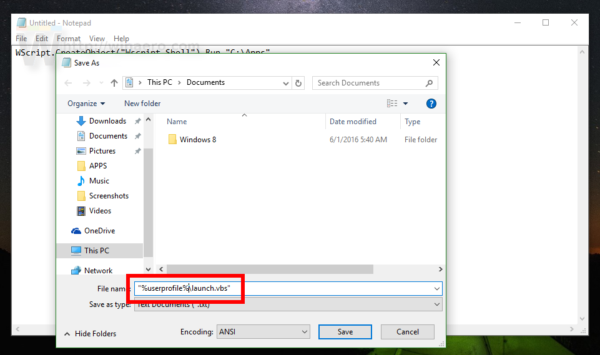
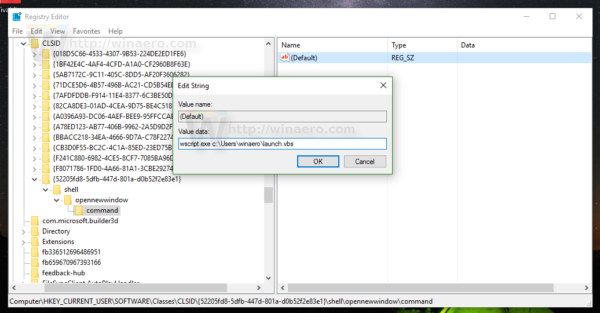

Nice trick! Thank you!
Another good one!
There is a much simpler solution.
Just open properties for the default File Explorer shortcut and change the field “Target:”.
If you want File Explorer to open in the folder C:\Folder just enter the path at the end like this:
C:\Windows\explorer.exe C:\Folder
You do not understand the subject reviewed in the article.
The method you described:
1. Will not change Win+E behavior
2. Will produce an additional icon in the taskbar in case you have Explorer pinned to the taskbar.
So no, even if your solution is simpler, it is far from perfect.
In addition to what Sergey said, this solution doesn’t work if you’re in a computer with limited edit permissions.
Thank you! I have been looking for this solution for a while. The “target” option in the File Explorer properties dialog is greyed out, so I couldn’t change it. This worked perfectly. I have Windows 10 Pro
I’ve looked everywhere to find a hack to make this work since the most recent Windows 10 update and you’re the only one who offered a working solution. Thank you so much!
You are welcome.
Thank you! Works perfectly.
You are welcome.
Thank you Sergey, this is the first and so far only working solution I have found to the duplicate taskbar issue with Windows 10, the Win-E shortcut is just icing on the cake. Phew. This took a couple of hours, unusual but I guess the relatively narrow scope of this feature regression (as compared to Win7) keeps the majority of people from seeking a proper solution plus the web is full of non-solution-solutions to the issue. Will make sure to pass the link to your article onwards to colleagues.
You are most welcome!
Could you please add this one to Winaero Tweaker 10.3? It seems super useful; just the sort of tweak that every Windows installation should have access to, just like Winaero Tweaker.
I had thar horrible “shell:::{52205fd8-5dfb-447d-801a-d0b52f2e83e1” error but it was simply fixed, this solution here was too complicated then I tried another one I saw in a forum, just searching a .reg documend (folder_fix_w10.reg for windows 10), in other words, googling “FOLDER FIX WINDOS x”, it sb downloaded in a zip file, you can directly open the zip in the downloads items in your internet explorer, chrome etc, or simply creating and empty zip file in your desktop and use that winrar/zip explorer and extract the “folder_fix_w10.reg” double click and confirm yes…. voilá! problem solved
that’s awesome, thank you so much !
This is great but unfortunately it won’t allow me to open multiple instances (or at least not through windows+e shortcut) at the same time….
Is there a way to fix this??
It works…. or lets say it almost works
If I set destination to “c:\software”, then it works, but
If I set destination to “c:\software installs” then it fails
Every time there is a space ” ” in destination it fails!
What to do? I cant just rename the destination in my case!
put the destination path into quotes
WScript.CreateObject(“Wscript.Shell”).Run “””C:\My Folder with spaces”””